By Dan Larsson
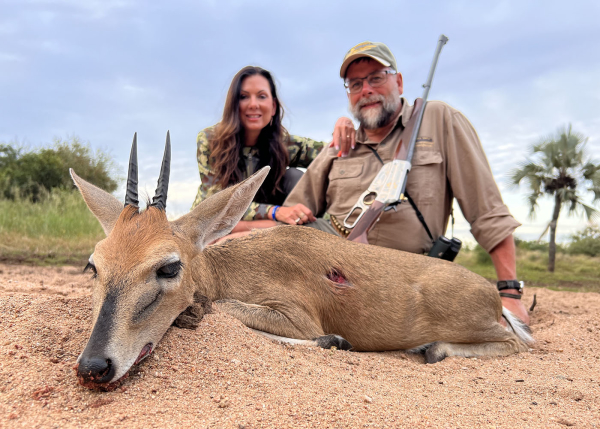
Sheila and Andy Larsson and the now famous Winchester 95 chambered in 9.3x62mm Mauser at work.
The adage is true. There are two types of critters in the woods, “Dan and targets.” Everything became a potential target, and I learned proper firearm use and gun safety. This little lever gun is made of metal and wood. It weighs more than modern BB guns and is a fantastic shooter. Made in 1965, that Daisy 102 Cub is a sweetheart. It still works and resides in his office today.
Speaking of dads …
My father, Andy, inspired me through the experiences he enjoyed as a child. I watch daily how he uses his experiences to help and encourage others. There is a lot of knowledge and experience in his background for which I am grateful. Can we call him the modern King of the Lever Action? Maybe. He has done more than most to promote and further the use of this historic American action over the last couple of decades. Whatever we call him, he’s my dad and I’m proud to say it.
Andy now owns and operates his Skinner Sights business with his wife, Sheila. His love for lever-action rifles is growing on Sheila who now has her own gussied-up Marlin 1894 .44 magnum. It is a beautiful octagonal-barreled rifle with engraving and a color case finish by Bobby Tyler of Tyler Gun Works. They occasionally spend time at the Gunsite Academy training with her baby (.44 mag), and it accompanies them to most of the industry shows around the country. Sheila has a quirk. Yes, just one. She names all her guns. This rifle is now known by many as Stella.
I asked Andy several questions to share with you. Enjoy!
What are some of your most sentimental lever-action rifle hunts?
“When I was 10 years old, my family was hunting the fringe of a field near Fort Benton Montana. This was a surplus (B) tag hunt targeting antlerless deer. I wasn't old enough to hunt yet but tagged along to "be there". My father and two sisters held about five tags between them. A stalk was made down the side of the field in a dry wash. Half a dozen deer were feeding in the open. Once in position, they each picked one out and a volley of shots rang out. Three deer went down. Another shot rang out. A fourth deer was hit, and it disappeared into a "break" that led down to the river.
Dad had his hands full working with my sisters on the three down, he turned to me and said, "Andy, take the 30-30 and follow that other one down the coulee. If it's still up, put it down... " I was 10. Legal age to hunt in Montana at the time was 12, but I didn't argue as to me, this was a serious obligation and represented a lot of trust.
The "30-30" was a Winchester 94, saddle ring carbine with a worn-out barrel that "key-holed" the bullets at 50 yards. The outside showed honest 75-year-old wear, much of the bluing was missing, the wood smooth and worn, some notches had been carved into the straight grip (no one knew what they meant), it had a full buckhorn rear sight and a slim silver blade front. To say it "felt good" in my hands (at 10) is an understatement. With it I had all the firepower of a small naval gunship at my disposal.
I picked up the blood trail at the edge of the field, slowly followed it down the dry, sagebrush littered coulee for a hundred yards till I could see ears poking up over a bush. Easing around the opposite side of the gully I gained a little elevation to see over the brush. Yep, this was the right one, she was down but not out. The rifle came up smoothly, sights steady, hammer back, and at about 50 yards that sideways bullet took her right between the eyes. It was instant, humane, and I was jubilant!
I traded that 94 off two years later to the City Chief of Police for a Ruger Blackhawk 357. Kinda wish I had it back but the Blackhawk has been a companion now for 53 years and I have no regrets.
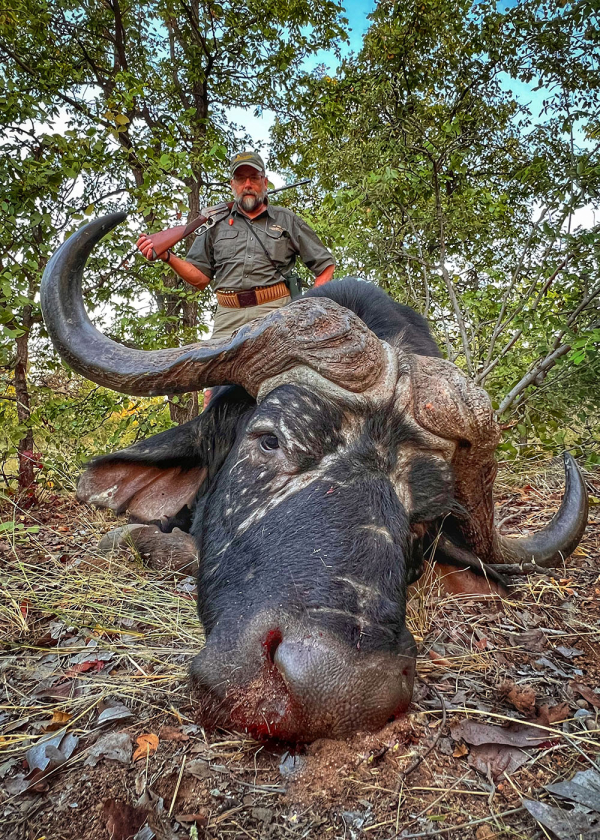
The 9.3x62mm Mauser in action.
There have been a lot of lever guns come into the fold since then but one that stands out is my 1895 Winchester chambered for 9.3X62 with a Skinner Sights bolt mounted peep. It's been to Africa several times, has killed everything from Duiker to Cape Buffalo, Waterbuck, Nyala, and Kudu. The feel of that 1895 in the hands takes me back to a late evening walk down a river break in the prairies of Montana, so many years ago. When the lever is worked, a chunky piece of brass whooshes overhead and you can smell the acrid smell of gunpowder as the scene of the hunt unfolds before you. It's Magical....”
What are your favorite three lever-action calibers to use and why?
“Marlin 39 Century Limited, 22 LR, Slim tapered octagon barrel, straight grip, and sleek forend. Why: This is one of the best balancing lever actions ever built, the 22 chambering means lots of practice and inexpensive shooting plus fantastic for small game and varmints. A 22 gets shot much more than centerfires due to the cost of ammunition, low recoil and report, and can be used almost anywhere. Everything to like, nothing to hate.
Skinner Sights 44 Magnum BUSH PILOT, octagon barrel, 1892 Winchester clone, hard chrome finish, and Skinner mag tube mounted flashlight mount coupled with a Skinner SUPER SLING. This is the perfect backcountry personal defense and short-range hunting rifle. The 44 with the right bullet construction is excellent on bear, adequate for other large game, has a low profile when carrying in urban areas and with my Olight/flashlight/laser combo you "own the night".
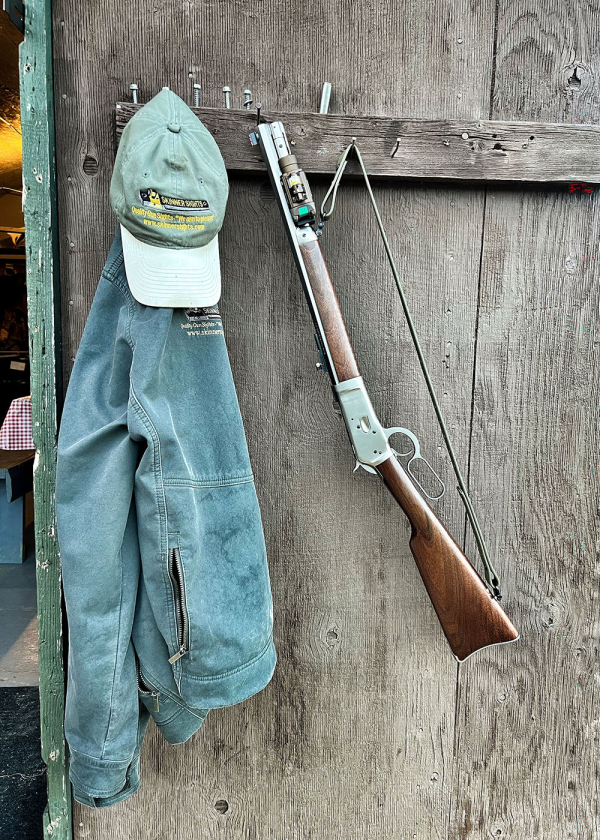
The Skinner Bush Pilot is a takedown 1892 Winchester clone.
Winchester 1895 9.3X62 with Skinner bolt-mounted peep sight, mid barrel banded sling mount, high grade wood, and Miroku high grade engraved receiver. This rifle shoots as well as it looks. It's a powerhouse throwing a 250 gr. Barnes TSX bullet at 2400+ fps. Easy to shoot, has a romantic feel in the field, enough power for up to Cape Buffalo, and holds 5 rounds for when things get dicey. It has a custom medium weight tapered barrel and balances well in the hand making for a quick handling, hard-hitting powerhouse of a rifle.”
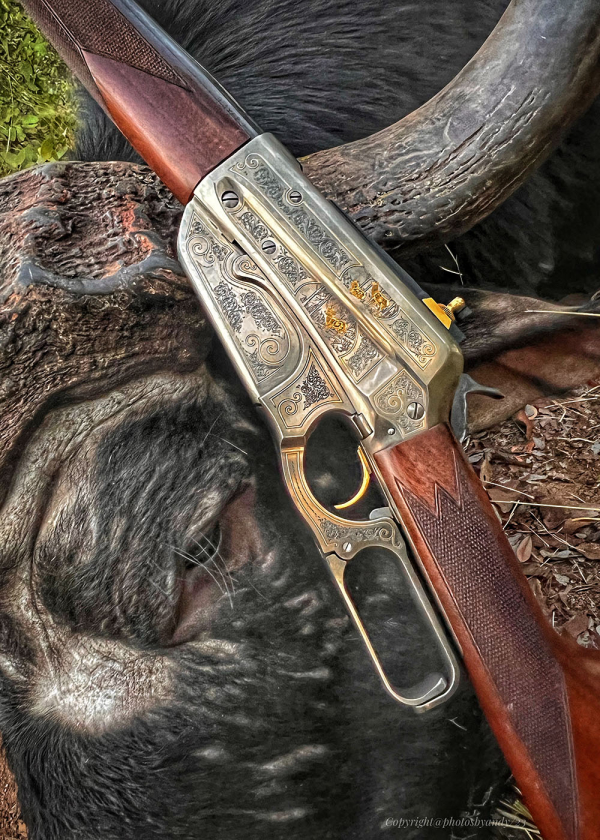
The Winchester 1895 chambered in 9.3x62mm
If a new shooter wants to buy a lever-action, what questions should they ask themselves?
“What do I intend to do with this rifle? Plink, target practice, hunt small game, hunt big game, home defense, or wildlife defense? Each of these will dictate what kind of lever gun will suit you best. I always recommend getting a 22 for the first three categories. Even if you plan to get something for the others, the 22 will serve you well and be the most fun rifle/carbine in your gun safe. Look at the Henry H001 Small Game Carbine/Rifle. They are classy with an octagon barrel, won’t break the bank, are accurate, and come with a Skinner Peep Sight factory installed.”
What is an interesting trivia fact about lever-action rifles?
“They are America's own Iconic platform, developed and proven here in the USA. They were the original "High-Capacity Assault Rifle". If everyone who owns a lever gun, were laid down end to end, they would be a lot more comfortable.”
What is the oldest lever gun you own?
“An 1873 Winchester chambered in 38 WCF (Winchester Center Fire) or otherwise known as a 38-40. I found it in a pawnshop in Mississippi just off the shore of the Gulf of America.”
How tall should my front sight be?
“There are many variables that determine front sight height unique to each rifle.
Firearms are not like Automobiles. If you need a part for your car or truck, you can specify the Make, Model, Year, and serial number of your vehicle and get the part you need. This would also be true of many parts of your firearm. (stock, extractor, trigger group, magazine, etc.) Sight height however is much more individual because there are many variables that affect the path a bullet takes leaving the muzzle. Some of the variables are:
Ammunition: Bullet weight, Powder charge, Primer, Ammo brand, all affect bullet impact in relationship to the sights. There is a brand of Ammunition that features a flexible point on the tip of the bullet and generates more velocity than some loads of comparable bullet weight. This bullet has a better ballistic coefficient which coupled with higher velocity results in a flatter trajectory and normally groups higher than conventional ammunition.
Rifle: Barrel angle to receiver changes are amplified when a sight is mounted on the receiver. When both sights are mounted on the barrel this variable is eliminated. Most rifles are lined up normally and work well with receiver sights. The crown of the barrel can also affect the bullet’s impact on the target. This isn't the norm but also isn't uncommon. Each rifle has its unique characteristics that may influence front sight height.
Shooter: As the gun recoils, a shooter's height, weight, strength of grip, cheek pressure, and trigger squeeze all affect the angle of departure as the bullet leaves the barrel. Also, each shooter views or perceives the sight picture slightly differently. (This is minimized with a peep/aperture sight.) This is why a firearm sighted in by one individual may group differently for another.
If you are installing a new rear sight (I always recommend SKINNER SIGHTS) the process is simple and foolproof. Install the new rear sight, replace the factory barrel mounted-sight with a dovetail slot blank, and shoot two shots on paper at 25 yards with the factory front sight. The results will tell us immediately if a taller or shorter front sight is needed and how much taller or shorter it will need to be. At Skinner Sights we are here to help you through this process if needed. Just give us a call.”
Can you give a brief history of Skinner Sights?
“Dr. Tim Skinner was a math teacher, principal, and school superintendent in St. Ignatius Montana where I live. He is also an avid outdoorsman/hunter/shooter and innovator. When he retired from public school, he wanted to learn to use a milling machine and lathe. I'd always done his gunsmithing for him and had known him for 30 years. He reached out to me, we talked some, he got a small mill and a lathe for his basement, and I didn't see much of him for a couple of years. One day he handed me a rear sight for a Marlin 1894. I said, "What's this"? He said, "I was out on horseback the other day with my Marlin in a scabbard. It had an (other brand of peep sight) on it and it kept falling apart in the scabbard. Then it broke. I came home and built me a sight that won't break. Take this one and try it out...
I did, loved it, and went on about life. A couple of years later he approached me about making some sights for him. I was making some changes in my life and had not found a new career path yet. I said OKAY, built one of the sights he wanted made, took it to him for inspection, he looked at it, then at me and said, "That’s better than the ones I made, why don't you buy my business?" Turns out he was making them in his basement and selling through SkinnerSights.com and on eBay. Long story short, that was 15 years ago this coming end of July 2025, and I haven't looked back. Today we have 8000 feet of manufacturing space, 15 employees, some state-of-the-art CNC Equipment including Robotics, and supply several major firearms manufactures as well as delivering consumers direct. We are proud to be one of the leading gun sight manufacturers today. Our product line has expanded to include three different optics, optic mounts, other useful tools, and firearm accessories as well as a cut N sew shop where I design, and we produce unique and practical firearm storage and carrying cases as well as other soft goods I wanted for my use in the field.”
Tell us about your sewing shop.
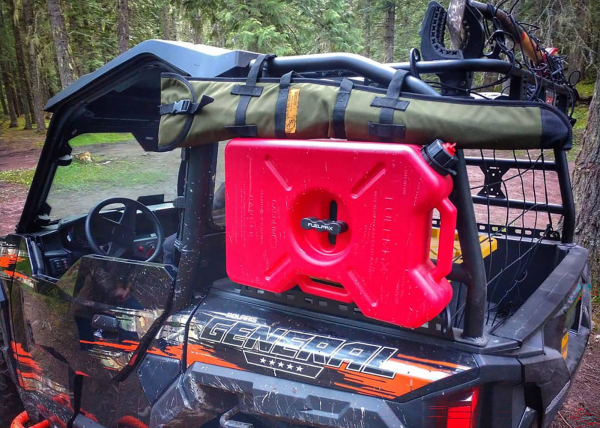
Skinner Sewing goes anywhere
“After purchasing Skinner Sights 15 years ago, there were other things I'd always wanted in my outdoor pursuits here in the Mountains of Montana. I started designing gun cases, scabbards, concealed carry garment bags, Bible cases, money belts, cartridge pockets, and belt pouches, etc. At first, I enlisted the services of a local cut-n-sew shop and eventually purchased that business and brought it all in-house. We are proud to say our products are built in Montana, USA, and are crafted of the best materials with durable construction that will last for years. These are all products I use myself and stand behind them 100-percent.”
Learn more at www.skinnersights.com